St Giles-in-the-Fields and St George Bloomsbury, Middlesex, London
Up to 1834
In 1725, the joint parishes of St Giles-in-the-Fields and St George erected a parish workhouse in Holborn at the north side of the junction of Endell Street and Short's Gardens, with its entrance at the north side on a narrow thoroughfare called Vinegar Yard (later Vinegar Lane).
In 1732, the workhouse was the subject of an entry in the early workhouse directory, An Account of Several Workhouses..., which began:
THIS Parish and St. George Bloomsbury, being lately one Parish, the Act of Parliament for dividing of them, has made Provision, that the Poor, receiving Alms of each Parish, shall continue on the same foot as they were before their Division; accordingly the Churchwardens and Overseers of the Poor in each parish, are in Concert, and contribute in proportion as they formerly did, towards the Support of a large Workhouse erected 1725, near Broad St. Giles's, with Accommodations for lodging, dieting, and employing several Hundreds of both Sexes of the Poor.
THE rich Inhabitants of both Parishes were so well disposed to encourage a Design for employing and relieving their numerous Poor, that they contributed so many Benefactions towards it as enabled the Churchwardens and Overseers of the Poor to buy and repair this House, and the Ground adjoining, which now serves for a Burying-place, without any new Tax on the Parish.
THERE are now generally maintained in it upwards of 260 in the Summer time, and above 300 in the Winter time, and the Poor's Tax is reduced about a fourth part of what it was before the Erection of this House.
THE Management of it is so wisely regulated by the Assistance of some active Justices of the Peace in both Parishes, as to deserve a particular Notice to be taken of it, for the Imitation of other Places under the like Circumstances.
The Account also included the workhouse's lengthy rules and regulations. It was also noted that in July 1728, the workhouse had a population of 238 inmates in 23 wards, containing a total of 157 Beds. They were served by 14 nurses and 8 assistants.
The site gradually expanded and incorporated adjacent properties including several houses and an inn, resulting in a very irregular collection and arrangement of buildings. In 1777, the workhouse could accommodate 520 inmates. The workhouse location and layout in 1819 are shown on the map below.
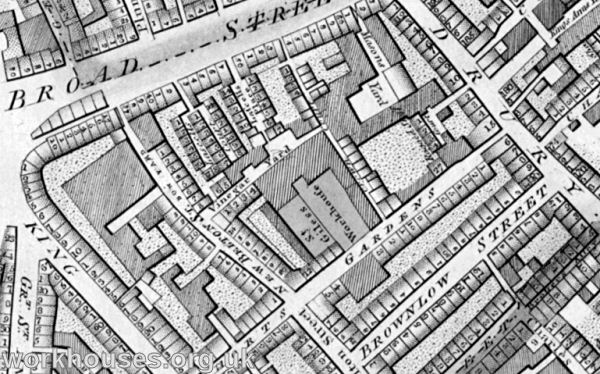
St Giles & St George workhouse site, 1819.
After 1834
St Giles and St George retained special parish status after the passing of the 1834 Poor Law Amendment Act and continued to administer its own poor relief arrangements.
The workhouse in Endell Street continued in use, with the main addition being an infirmary erected in 1844 at the north side of Vinegar Lane as shown on the 1871 map below. The map also identifies a men's yard at the north-east of the workhouse, a women's yard at the centre, a drying yard at the west, and a stone yard to the south.
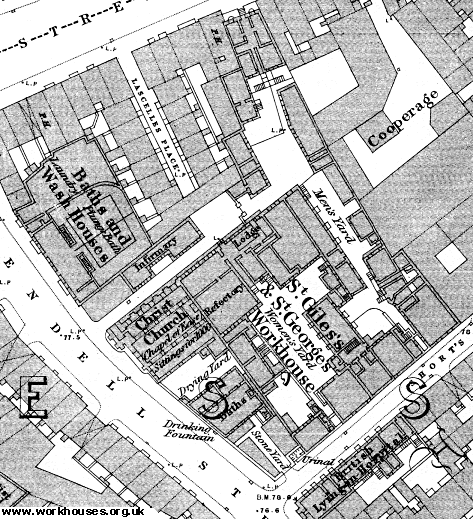
St Giles and St George workhouse site, 1871.
In July 1865, St Giles and St George was the subject of one of a series of articles in the medical journal The Lancet investigating conditions in London workhouses and their infirmaries. The report, of which an extract appears below revealed a catalogue of appalling conditions in the buildings.
The existing workhouse (with a north frontage) is a brick-built structure, consisting of various detached and connected erections, three or four stories high, in the form of a parallelogram, with the originally vacant space well covered and walled in, dating from 1727. The site is relatively high and dry, the subsoil gravel, and the drainage and water-supply good. The house was built for 850 paupers ; in times of pressure the number reaches over 900.
The infirmary (east by west) is also of brick, and was erected in 1844 for 105 patients, male and female. There are four male and three female wards — i.e.
| No. 1, for 18 males, with | 12,400 cubic feet. |
| No. 2, for 14 " | 9,700 " |
| No. 3, for 9 " | 6,334 " |
| No. 4, for 18 " | 7,686 " |
| No. 1, for 18 females, with | 12,500 cubic feet. |
| No. 2, for 14 " | 9,300 " |
| No. 3, for 14 " | 2,610 " |
The space allotted to each patient is in our opinion far too limited, and especially so in No. 4 male ward. During our visit in June last there were 64 cases in these wards; and even with this limited number there was a condition of atmosphere far from sweet, due in part to defective ventilation and the absence of pure light, and also probably to other sources of neglect. Still, excepting the cellar ward No. 4, made notorious by the Gibson inquiry, it is possible to make this infirmary adapted to hospital purposes. So much, however, would have to be done — so many alterations and removals of surrounding buildings — the additions of new closets, baths, and lavatories-better approaches to existing stairs-special kitchens and nurses' rooms, — in a word, so much change is needed, that in our opinion it would be more economical to condemn the infirmary along with the defective and ill-contrived house. With regard to ventilation in all these wards, we have never seen worse; practically, it is nullified by the gratings opening into the chimneys and the rafter chambers amid-rooms, instead of directly communicating with the outer air.
The furniture of the wards, including bedsteads, beds, and bedding, was found very faulty. The iron bedsteads, as a rule, were short of six feet, and were not more than two feet five inches in width. In many cases the sacking was in rags, loose, and dirty, the beds of flock, with dirty ticks, in some cases extremely dirty, and the flock escaping on the sacking ; the blankets and sheets also were dirty and ragged. The sheets we were told were changed when required, and always once a fortnight — statements we could hardly credit when looking at the articles themselves. The arrangements for washing the patients indicated the same laxity ; the ward towels were small, dirty, and ragged, and yet we were told that there were plenty in stock, and only required to be sent for, which indeed proved to be true on our asking to see them.
Disorder and neglect appeared to be in authority as a direct consequence of the so-called system of nursing which obtains here, directed by an aged female, 63 years old, with a salary of 20l. per annum. Under her supervision there are fourteen pauper assistants or helpers, with two night-nurses, selected from those who perform the day-nursing, none of whom receive remuneration for their labours. Well may the Poor-law Inspector remark — "It has always seemed to me desirable that the directors should encourage the nurses with some pecuniary allowances and rewards." Let us hope that before long the whole subject of nursing will be carefully reconsidered, and so arranged that the poor will be tended in their hour of trial, and that the medical officers will have helpers rather than obstructors in their efforts to relieve and cure the sick.
Leaving the infirmary, we next entered the infirm wards, situated on the north, and which were devoted to the sick previously to the erection of the present hospital. Here we found about 100 aged persons occupying very defectively arranged wards, wanting both in light and ventilation. The beds and bedding were in keeping with what we have described as existing in the infirmary — many worn out, and many more dirty. Doubtless much of the dirt had arisen from the habit of conveying the coals into the basement wards, and shunting them into cellars through openings made in the floor. This habit of "coaling for the house" not merely brings a large amount of dust into these wards, but also produces a strong and disagreeable smell in them, and which, combined with other obnoxious vapours incident to the bed-ridden, unless great care is taken to keep them clean, produces an atmosphere really injurious to the occupants. The upper wards are in the roof, which we found oppressively hot and badly ventilated. Defective space in all these wards is too self-evident, and must tend to continue invalidism, which better accommodation would help to cure.
The most objectionable wards in the house are, however, devoted to child-birth; they are in the roof, with low and slanting ceilings, defective light and ventilation, and will be commented on in our special report on this subject.
It is really gratifying to turn from these subjects, of which in common honesty and truthfulness we are bound to speak in condemnation, to others of a more pleasing character. The various foods and drinks which we tasted were found, without an exception, good. The mode of preparation appeared to be all that could be desired, save in some matters of detail to which we may take exception when we come to speak on this subject, and particularly on the dietary of the infirm. Many of these poor creatures, aged, but free from acute illness, are placed on the house diet, which in some of its articles is wholly unfitted for them. Physically, many of them are as children, and require a diet adapted to early life. We shall, however, on some future occasion resume this subject.
The absence of accommodation for classifying the patients, the defective hospital arrangements, the position of the lying-in wards in the roof of the main building, and the inadequate space for the infirm, must complicate the labours of the medical officers.
The outcry that The Lancet articles provoked was a significant factor leading to the passing of the Metropolitan Poor Act in 1867. The Act introduced major changes in the provision of care for London's sick poor and also resulted in the creation of the Metropolitan Asylums Board (MAB).
In 1888, a new infirmary was erected at the north side of Shorts Gardens — a square five-storey tower, designed by William and Arthur Beresford Pite. The ground floor contained offices for the outdoor relief officer, medical officer and dispenser, as well as large waiting and committee rooms. Separate staircases for males and females led to the upper floors. On the first and second floors were wards for imbecile inmates, with two padded rooms. The third and fourth floors provided for itch and bad leg cases.
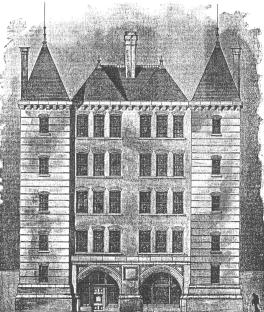
St Giles and St George workhouse infirmary, 1888.
On New Year's Eve, the inmates of St Giles' were given an "entertainment" which in 1881 was the subject of a report in the Illustrated London News:
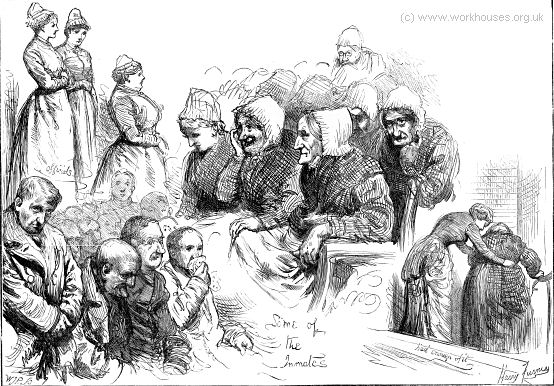
St Giles inmates — New Year's Eve, 1881.
In 1895, the purchase of run-down court of houses in Short's Gardens allowed a further infirmary block to be added at the east of the workhouse site. It included six large wards, a dispensary, a large casual ward, and additional dormitories. In the course of this work, the workhouse's former burial ground was uncovered where large numbers of remains were found within two feet of the surface. The site layout is shown below on the map of 1895.
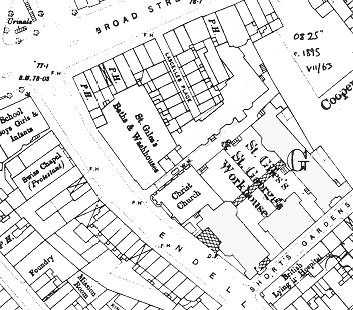
St Giles and St George workhouse site, 1895.
In 1902, a new building containing a receiving house for children and a nurses' home was erected on Broad Street to the north of the St Giles' workhouse. The ground floor of the building contained a dayroom for the children, lavatories, cloakrooms, kitchen, scullery and stores. On the first floor were children's dormitories and bathrooms, and officers' apartments. The second floor contained further dormitories, isolation wards, and servants' bedrooms. The third floor, reached by an emergency staircase at either end of the building, comprised apartments for nurses employed in the workhouse, including a bedroom and sitting room for the superintendent nurse, six bedrooms and a sitting-room for the nurses and assistant nurses, and a bathroom. The architect was Mr J Grafton Izard, and the builder was Mr Alfred Bush.
New Year concerts were still taking place in 1904, on which occasion the proceedings were overseen by Chairman of the Board of Guardians, James Haxell Esquire. The programme for the concert is shown below, together with a newspaper review of the occasion.
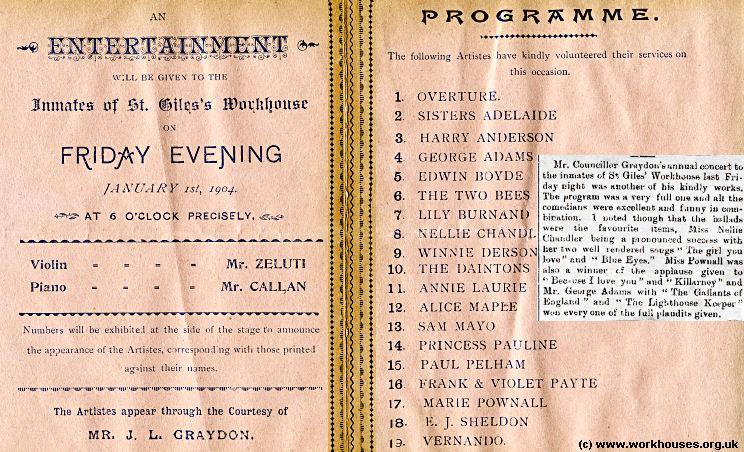
St Giles New Year concert, 1904.
St Giles casuals' wards for vagrants were located to the north-east of the workhouse site at 25-27 Macklin Street, with a stone-yard to the rear. These, together with all the capital's other casuals' wards, were taken over in 1912 by the Metropolitan Asylums Board.
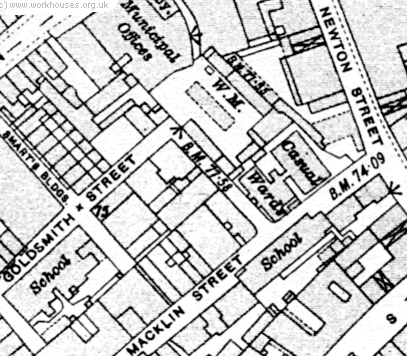
Bloomsbury casual wards site, 1916.
In 1914, St Giles-in-the-Fields and St George Bloomsbury became part of the Holborn Poor Law Union. In March 1915, the parishes' workhouse infirmary on Shorts' Gardens was taken over for use as a military hospital for 537 'other ranks'. It was staffed almost entirely by women.
The former workhouse buildings have all since been demolished.
Staff
Inmates
- Long-term workhouse inmates (1861)
- 1881 Census — Endell Street workhouse
- 1881 Census — Macklin Street Casual Ward
Records
Note: many repositories impose a closure period of up to 100 years for records identifying individuals. Before travelling a long distance, always check that the records you want to consult will be available.
-
The
Ancestry UK
website has two collections of London workhouse records (both name searchable):
- Westminster workhouse records are available on FindMyPast, .
-
London Metropolitan Archives, 40 Northampton Road, London EC1R OHB.
Holdings include:
- Endell Street workhouse holdings include: Creed registers (1879-1914); Deaths (1872-1914); etc.
- Broad Street workhouse holdings include: Admissions and discharges (1869-80); Creed registers (1879-1914); etc.
- Broad Street children's receiving home holdings include: Admissions and discharges (1902-10); Creed registers (1903-15); etc.
- Other holdings include: Guardians' minute books (1868-1914); Financial records (1869-1915); Staff records (1913-14); etc.
Bibliography
- Higginbotham, Peter Workhouses of London and the South East (2019)
- The Lancet, July 15, 1865.
Links
- None.
Unless otherwise indicated, this page () is copyright Peter Higginbotham. Contents may not be reproduced without permission.


